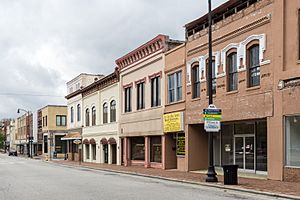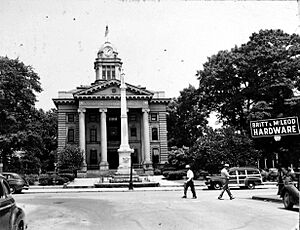Lumberton, North Carolina facts for kids
Quick facts for kids
Lumberton, North Carolina
|
||
|---|---|---|

North Elm Street
|
||
|
||
| Country | United States | |
| State | North Carolina | |
| County | Robeson | |
| Named for | Lumber River | |
| Area | ||
| • Total | 17.84 sq mi (46.20 km2) | |
| • Land | 17.76 sq mi (46.00 km2) | |
| • Water | 0.08 sq mi (0.20 km2) | |
| Elevation | 135 ft (41 m) | |
| Population
(2020)
|
||
| • Total | 19,025 | |
| • Density | 1,071.29/sq mi (413.62/km2) | |
| Time zone | UTC−5 (Eastern (EST)) | |
| • Summer (DST) | UTC−4 (EDT) | |
| ZIP codes |
28358-28360
|
|
| Area codes | 910, 472 | |
| FIPS code | 37-39700 | |
| GNIS feature ID | 2404974 | |
| Website | www.ci.lumberton.nc.us | |
Lumberton is a city located in Robeson County, North Carolina, United States. In 2020, about 19,025 people lived there. It is the main city and county seat of Robeson County.
Lumberton is found in the southern part of North Carolina, along the Lumber River. It was started in 1787 by John Willis, who was an officer in the American Revolution. The city was important for shipping lumber (wood) that was used by the Navy. Logs were floated down the river to Georgetown, South Carolina. Lumberton grew a lot after World War II.
Contents
History of Lumberton
Robeson County in North Carolina was created in 1787. General John Willis, who owned a large farm called Red Banks plantation, wanted the new county government to be on his land. Lumberton was chosen because it was in the middle of the county. It was also near a good place to cross the Lumber River and where several roads met.
Willis gave 170 acres of land for the new town. This land was measured and given out in a special drawing on August 14, 1787. Since the area had many trees, they were cut down to make space for a courthouse, shops, homes, streets, and a public square. The first courthouse was a wooden house that Willis sold to the county.
Lumberton officially became a town on November 3, 1788, when the North Carolina General Assembly passed a law. This law gave the town a charter and the power to collect taxes. The town was named after the Lumber River.
The first buildings in Lumberton, besides the courthouse, were brick structures near the river. These included a hotel, stores, and warehouses. Goods were brought up the river from Georgetown, South Carolina, to fill these warehouses. The town's first school was started by Willis in 1791. By 1796, Lumberton had a post office.
The town officially became a city in 1852. It then had a local government with a mayor and a group of commissioners. In 1860, a railroad connected Lumberton to Wilmington, North Carolina. This meant the town didn't rely as much on river trade from Georgetown anymore.
In 1970, Lumberton was given the "All-America City" award by the National Civic League. This award recognizes cities that work together to solve problems. Many businesses moved out of the downtown area in the mid-1970s. In 1995, the city won the All-America City award a second time.
In 2016, Hurricane Matthew caused a lot of flooding in Lumberton, setting a new record. Then, in 2018, Hurricane Florence hit the county and broke that flooding record. Because so many homes were damaged, entire streets in south and west Lumberton were left empty.
Several important buildings in Lumberton are listed on the National Register of Historic Places. These include the Baker Sanatorium, Luther Henry Caldwell House, Carolina Theatre, and the US Post Office-Lumberton.
Geography and Location
Lumberton is part of the Carolina Border Belt. This is an area with many tobacco markets and warehouses on both sides of the North Carolina-South Carolina border.
The United States Census Bureau says that the city covers about 15.8 square miles (40.9 square kilometers). Only a very small part of this area, about 0.1 square miles (0.2 square kilometers), is covered by water.
Lumberton is located on the Lumber River in North Carolina's Coastal Plains region. The Lumber River State Park, which is 115 miles (185 km) of beautiful natural waterway, flows through Lumberton.
You can reach Lumberton by using Interstate 95 and Interstate 74.
Climate
Lumberton has a humid subtropical climate. This means it has hot, humid summers and cool winters.
| Climate data for LUMBERTON MUNI AP, NC, 1991-2020 normals, extremes 1903-present | |||||||||||||
|---|---|---|---|---|---|---|---|---|---|---|---|---|---|
| Month | Jan | Feb | Mar | Apr | May | Jun | Jul | Aug | Sep | Oct | Nov | Dec | Year |
| Record high °F (°C) | 82 (28) |
84 (29) |
96 (36) |
96 (36) |
101 (38) |
104 (40) |
108 (42) |
106 (41) |
104 (40) |
99 (37) |
87 (31) |
83 (28) |
108 (42) |
| Mean daily maximum °F (°C) | 54.6 (12.6) |
58.6 (14.8) |
65.8 (18.8) |
74.7 (23.7) |
82.5 (28.1) |
88.8 (31.6) |
91.0 (32.8) |
89.1 (31.7) |
84.2 (29.0) |
75.9 (24.4) |
65.9 (18.8) |
57.5 (14.2) |
74.1 (23.4) |
| Daily mean °F (°C) | 44.9 (7.2) |
48.0 (8.9) |
54.5 (12.5) |
62.7 (17.1) |
71.0 (21.7) |
78.8 (26.0) |
81.6 (27.6) |
80.0 (26.7) |
74.5 (23.6) |
64.2 (17.9) |
54.1 (12.3) |
47.5 (8.6) |
63.5 (17.5) |
| Mean daily minimum °F (°C) | 35.3 (1.8) |
37.4 (3.0) |
43.1 (6.2) |
50.7 (10.4) |
59.5 (15.3) |
68.7 (20.4) |
72.3 (22.4) |
70.9 (21.6) |
64.8 (18.2) |
52.5 (11.4) |
42.4 (5.8) |
37.5 (3.1) |
52.9 (11.6) |
| Record low °F (°C) | −1 (−18) |
3 (−16) |
9 (−13) |
22 (−6) |
29 (−2) |
40 (4) |
50 (10) |
44 (7) |
35 (2) |
20 (−7) |
12 (−11) |
−2 (−19) |
−2 (−19) |
| Average precipitation inches (mm) | 2.55 (65) |
2.77 (70) |
3.26 (83) |
2.85 (72) |
3.41 (87) |
4.92 (125) |
4.61 (117) |
4.77 (121) |
4.93 (125) |
2.29 (58) |
2.95 (75) |
3.31 (84) |
42.62 (1,083) |
| Average precipitation days (≥ 0.01 in) | 9.1 | 8.7 | 9.6 | 8.3 | 10.0 | 11.5 | 12.2 | 13.4 | 10.3 | 7.8 | 7.9 | 9.3 | 118.1 |
| Source: NOAA | |||||||||||||
Population and Demographics
| Historical population | |||
|---|---|---|---|
| Census | Pop. | %± | |
| 1870 | 615 | — | |
| 1880 | 533 | −13.3% | |
| 1890 | 584 | 9.6% | |
| 1900 | 849 | 45.4% | |
| 1910 | 2,230 | 162.7% | |
| 1920 | 2,691 | 20.7% | |
| 1930 | 4,140 | 53.8% | |
| 1940 | 5,803 | 40.2% | |
| 1950 | 9,186 | 58.3% | |
| 1960 | 15,305 | 66.6% | |
| 1970 | 16,961 | 10.8% | |
| 1980 | 18,241 | 7.5% | |
| 1990 | 18,601 | 2.0% | |
| 2000 | 20,795 | 11.8% | |
| 2010 | 21,542 | 3.6% | |
| 2020 | 19,025 | −11.7% | |
| U.S. Decennial Census | |||
Lumberton is the main city in a larger area called the Combined Statistical Area. This area includes Lumberton and Laurinburg. In 2020, this larger area had a total population of 520,378 people.
2020 Census Information
| Race | Num. | Perc. |
|---|---|---|
| White (non-Hispanic) | 6,657 | 34.99% |
| Black or African American (non-Hispanic) | 6,764 | 35.55% |
| Native American | 2,500 | 13.14% |
| Asian | 379 | 1.99% |
| Pacific Islander | 23 | 0.12% |
| Other/mixed | 814 | 4.28% |
| Hispanic or Latino | 1,888 | 9.92% |
According to the 2020 United States census, 19,025 people lived in Lumberton. There were 7,142 households and 4,536 families in the city.
2010 Census Information
In the 2010 United States Census, there were 21,542 people living in Lumberton. The population was made up of different groups: 39.0% White, 36.7% Black, 12.7% Native American, 2.4% Asian, and 0.1% Pacific Islander. About 6.7% of the people were Hispanic or Latino.
Education
The Public Schools of Robeson County is the only school district in the county. It runs all the public schools in the area.
Notable People from Lumberton
Many interesting people have come from Lumberton, North Carolina. Here are a few:
- Brad Allen, an NFL referee.
- Benjamin Crump (born 1969), a civil-rights attorney.
- Hunter Foster (born 1969), an actor nominated for a Tony Award.
- Penny Fuller (born 1940), an actress in films, TV, and Broadway. She moved to Lumberton when she was 12.
- Tommy Greene (born 1967), a Major League Baseball pitcher.
- Johnny Hunt, who was elected president of the Southern Baptist Convention in 2008.
- Vonta Leach (born 1981), a fullback for the NFL's Baltimore Ravens.
- Ashton Locklear (born 1998), a gymnast.
- Gene Locklear (born 1949), a Major League Baseball outfielder.
- Mike McIntyre (born 1956), who was a U.S. Representative for North Carolina from 1997 to 2015.
- Angus Wilton McLean (1870–1935), who was the 56th governor of North Carolina from 1925 to 1929.
- Afeni Shakur (1947–2016), a well-known member of the Black Panther Party and mother of rapper Tupac Shakur.
- Ida Van Smith (1917–2003), a pilot and flight instructor.
- Tim Worley (born 1966), a former running back for the Georgia Bulldogs and NFL teams.
See also
 In Spanish: Lumberton (Carolina del Norte) para niños
In Spanish: Lumberton (Carolina del Norte) para niños






